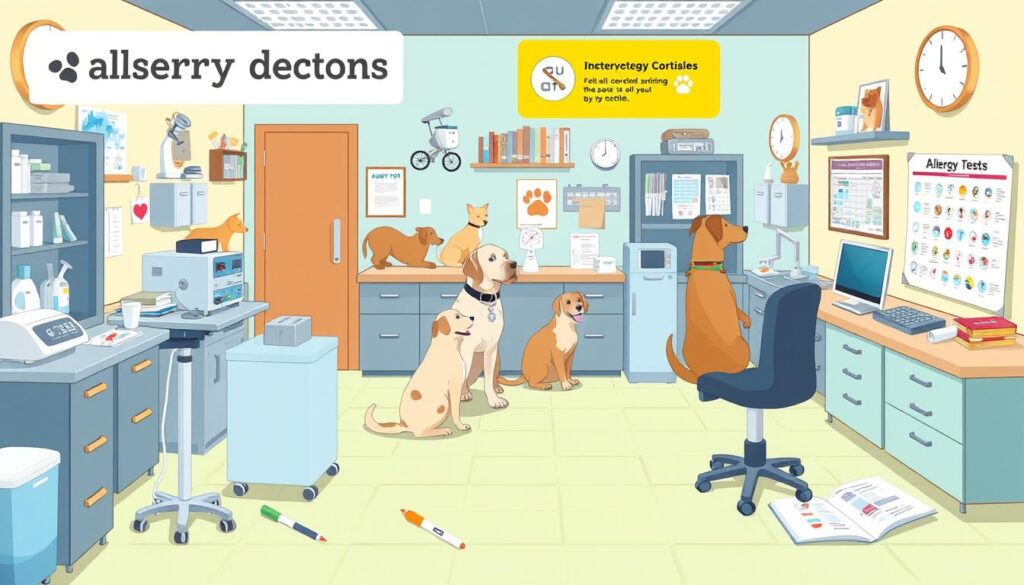Pet Allergy Treatments affect up to 30% of people in the United States. They are caused by proteins in pet dander, saliva, urine, and fur. Symptoms include sneezing, runny nose, itchy eyes, and skin rashes. These allergies can also make asthma attacks more likely.
There are many ways to manage pet allergy symptoms. Antihistamines like fexofenadine (Allegra Allergy), loratadine (Claritin), and cetirizine (Zyrtec) can help. They reduce itching, sneezing, and nasal congestion. Nasal corticosteroids, including fluticasone propionate (Flonase), mometasone furoate (Nasonex), and triamcinolone (Nasacort), also help by reducing nasal inflammation.
Immunotherapy, or allergy shots, is another option. It makes the immune system less reactive to pet allergens. This treatment involves gradually increasing exposure to the allergen. It requires maintenance shots every four weeks for 3 to 5 years.
Key Takeaways
- Pet allergies are a common condition affecting up to 30% of people in the U.S.
- Symptoms include sneezing, runny nose, itchy eyes, and skin rashes, as well as increased risk of asthma attacks.
- Effective treatments include antihistamines, nasal corticosteroids, and immunotherapy (allergy shots).
- Antihistamines and nasal sprays provide short-term relief, while allergy shots can provide long-term desensitization.
- Environmental control measures, such as HEPA filters and pet-free zones, can also help reduce allergen exposure.
Understanding Pet Allergies and Their Symptoms
Pet allergies are common and affect people exposed to proteins in animal skin, saliva, or urine. Cats and dogs are the main culprits, with their dander being the main allergen. People with a family history of allergies or asthma are more likely to get pet allergies.
Common Signs of Pet Allergies
Symptoms of pet allergies include sneezing, runny nose, and itchy eyes. You might also cough, wheeze, or get skin rashes. These signs can show up right away or take time to appear with long-term exposure.
Types of Pet Allergens
- Dander (shed skin cells)
- Saliva
- Urine
- Fur
Risk Factors and Prevalence
Cats and dogs are the top causes of pet allergies, with cat allergies being a bit more common in the US. Being exposed to pets early, especially dogs, can help kids fight off infections.
| Allergy Type | Prevalence in the US |
|---|---|
| Cat Allergies | 12.1% |
| Dog Allergies | 11.8% |
People with asthma and pet allergies often struggle to manage their asthma. This can lead to serious asthma attacks. Long-term exposure to pet allergies can also cause sinus infections due to nasal blockages.
“Not all hypoallergenic pets may be truly hypoallergenic since allergens can still be present in saliva and dander, even in low-shedding breeds.”
Professional Diagnosis and Testing Methods

Getting a correct diagnosis for pet allergies is key to finding the right treatment. Doctors use different methods to figure out what’s causing the problem. These include checking symptoms, doing physical exams, and running allergy tests.
The allergy skin test is a common tool. It involves putting a bit of the suspected allergen on the skin to see if there’s a reaction. Blood tests look for allergy-causing antibodies in the blood. Both methods help find out what’s causing the allergy.
Doctors might also check the nasal passages for signs of inflammation. This can show if pet allergies are present. Getting a correct diagnosis is important. It helps doctors create a treatment plan that works for the patient.
| Diagnostic Method | Description |
|---|---|
| Allergy Skin Test | Introduces small amounts of potential allergens to the skin to observe reactions. |
| Blood Test | Detects the presence of allergy-causing antibodies in the bloodstream. |
| Nasal Examination | Looks for signs of inflammation or swelling in the nasal passages. |
Doctors use these methods to find out what’s causing the allergy. This helps them create a treatment plan that works. It’s all about managing pet allergies effectively.
Pet Allergy Treatments

Living with pet allergies can be tough, but there are many ways to manage symptoms. You can try over-the-counter meds, prescription drugs, or immunotherapy. Each option helps in different ways, so you can find what works best for you.
Over-the-Counter Medications
For mild to moderate symptoms, antihistamines like Claritin, Zyrtec, and Allegra can help. They reduce inflammation and ease symptoms like sneezing and itching. Nasal sprays with corticosteroids also help with congestion and inflammation.
Prescription Solutions
For severe allergies, you might need prescription meds. These include stronger antihistamines, leukotriene modifiers, and corticosteroid nasal sprays. They target specific symptoms and help control the immune system’s reaction.
Immunotherapy Options
Immunotherapy, like allergy shots or sublingual tablets, offers long-term relief. It gradually builds up your tolerance to pet allergens. This can greatly reduce or even eliminate symptoms over time.
Choosing the right treatment depends on how severe your symptoms are and how you react to different meds. Always consult a healthcare professional to find the best plan for managing pet allergies.
Prevention and Environmental Control Measures

Managing pet allergies requires a few key steps. These include prevention and controlling the environment. By cutting down on allergen exposure, people with allergies can live better and feel better too.
HEPA (High-Efficiency Particulate Air) filters are a top choice. They catch pet dander, pollen, and other allergens in the air. This makes the air cleaner and reduces allergens at home. A good HEPA air purifier can really help with allergies.
- Setting up pet-free zones in the home is smart. This means keeping pets out of places like bedrooms. It helps lower allergen levels.
- Using a HEPA-filtered vacuum often is key. It gets rid of pet hair and dander from floors and furniture. Cleaning regularly helps keep allergens down.
- Washing bedding in hot water and using special mattress and pillow covers helps too. It gets rid of dust mites and other allergens in beds.
- Switching to hard floors like wood or tile is also good. It’s easier to keep these floors clean and free of allergens.
For those with very bad pet allergies, getting rid of the pet might be the best choice. It’s a tough step, but it can greatly improve health and happiness.
By using these steps, people with pet allergies can cut down on allergens. This makes it easier to live with their allergies every day.
| Allergen Avoidance Strategies | Effectiveness |
|---|---|
| HEPA air purifiers | Highly effective in reducing airborne allergens |
| Pet-free zones | Moderately effective in limiting exposure |
| Regular vacuuming with HEPA-filtered vacuums | Effective in removing pet hair and dander from surfaces |
| Replacing carpets with hard flooring | Highly effective in eliminating allergen reservoirs |
| Washing bedding in hot water | Effective in eliminating dust mites and other allergens |
| Rehoming the pet | Highly effective in eliminating the primary source of allergens |
Also Read: How To Treat Skin Infections In Pets Naturally?
Conclusion
Managing pet allergies requires a few steps. These include avoiding allergens, using medicine, and sometimes immunotherapy. While it’s hard to avoid all pet allergens, treatments can lessen symptoms a lot. This makes life better for those with pet allergies.
Seeing an experienced allergist is key to getting a good treatment plan. Many people with pet allergies can live with pets or lessen their symptoms. Knowing about pet allergies and how to treat them helps a lot.
Pet ownership is growing, especially in South Korea. This makes it more important to tackle pet allergies. With the right info and help from doctors, people with allergies can still enjoy pets. They can manage their symptoms well.
FAQs
Q: What are the common causes of pet allergies?
A: The common cause of pet allergies typically stems from exposure to pet allergens, which can include proteins found in the saliva, skin, dander, and urine of dogs and cats. These allergens can trigger allergic reactions in sensitive individuals.
Q: How can I determine if I am allergic to my pet?
A: To determine if you are allergic to your pet, you may consider getting an allergy test conducted by a healthcare professional. This test can help identify specific allergens, including those related to dog or cat exposure.
Q: What are the symptoms of pet allergies?
A: Symptoms of pet allergies may include sneezing, runny or stuffy nose, itchy or watery eyes, and skin rashes. In some cases, asthma and allergy foundation resources indicate that asthma symptoms may also worsen with exposure to pet allergens.
Q: What steps can I take to manage pet allergies?
A: To manage pet allergies, you can reduce exposure to pet allergens by frequently cleaning your home, using air purifiers, and keeping your pet out of certain areas. Additionally, bathing your pet regularly can help reduce the levels of pet dander.
Q: Are there medications available to treat pet allergies?
A: Yes, over-the-counter allergy medications, such as antihistamines and nasal corticosteroids, can help relieve symptoms. However, it is advisable to consult with a healthcare provider for appropriate diagnosis and treatment.
Q: Can pet allergies be treated permanently?
A: While there is no known permanent cure for pet allergies, treatment may focus on controlling pet allergy symptoms and minimizing exposure to allergens. In some cases, immunotherapy might be recommended for long-term relief.
Q: What should I do if I find out I’m allergic to my pet?
A: If you discover you are allergic to your pet, you can take steps to manage your symptoms, such as creating a pet-free zone in your home or considering options like finding a new home for your pet. Your healthcare provider can help you with a suitable action plan.
Q: How can I reduce allergy symptoms from my pet?
A: To reduce allergy symptoms, you can implement strategies like using HEPA filters, cleaning your home regularly, and minimizing your pet’s access to furniture. These actions can help remove pet allergens and improve your environment.
Q: Are cat allergies different from dog allergies?
A: Yes, cat allergies are often more common and can be more severe than dog and cat allergies. Cat allergens, particularly from cat saliva and dander, can linger in the environment and may cause stronger allergic reactions in sensitive individuals.
Source Links
- https://www.mayoclinic.org/diseases-conditions/pet-allergy/diagnosis-treatment/drc-20352198
- https://www.beckerentandallergy.com/allergy/pet-allergy
- https://my.clevelandclinic.org/health/diseases/17702-pet-allergies
- https://www.mayoclinic.org/diseases-conditions/pet-allergy/symptoms-causes/syc-20352192
- https://acaai.org/allergies/allergic-conditions/pet-allergies/
- https://www.petcareonhighland.com/blog/understanding-pet-allergies-signs-symptoms-and-solutions-pet-care-on-highland
- https://www.aaaai.org/conditions-treatments/allergies/pet-allergy
- https://www.ondemand.labcorp.com/lab-tests/dog-and-cat-allergy-test?srsltid=AfmBOoqGzGLt8M96QothZusjBlM6BncHh5QQROLv0yl5011q-9WH4OrE
- https://www.webmd.com/allergies/pet-allergies-triggers
- https://allergyasthmanetwork.org/allergies/allergies-to-dogs-cats-pets/
- https://itchypetvet.com/files/2018/06/Treatment-Options-for-Environmental-Allergies-in-Pets.pdf
- https://acaai.org/allergies/management-treatment/living-with-allergies/environmental-allergy-avoidance/
- https://pmc.ncbi.nlm.nih.gov/articles/PMC8689577/
- https://pmc.ncbi.nlm.nih.gov/articles/PMC5809771/
- https://pmc.ncbi.nlm.nih.gov/articles/PMC5893203/




